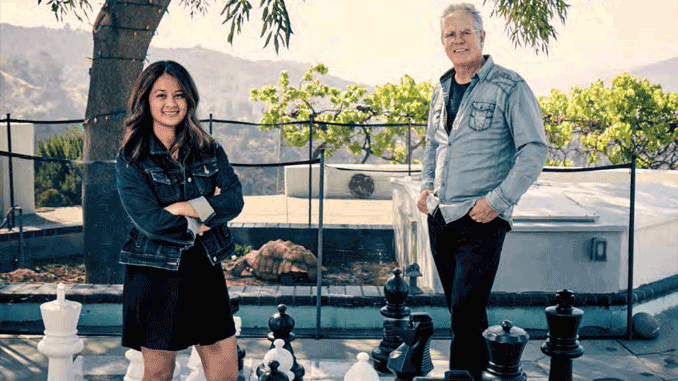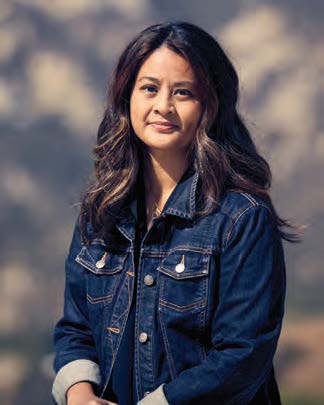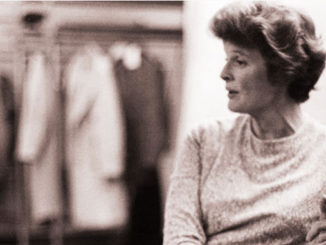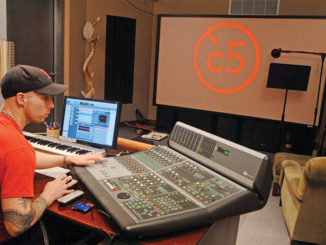
By Peter Tonguette
Picture editor Michelle Tesoro, ACE, wasn’t a chess expert when she began working on “The Queen’s Gambit.” And she still isn’t.
“I understand how the pieces move, just on a very rudimentary basis,” said Tesoro, the editor of the much-praised limited series that premiered last fall on Netflix. Writer-director Scott Frank’s adaptation of Walter Tevis’s novel of the same title chronicles the triumphs and trials of young Beth Harmon (played in adulthood by Anya Taylor-Joy), who, orphaned while still a child, is dispatched to an orphanage where she develops a gift for chess. Schooled in the game by the orphanage’s custodian, Mr. Shaibel (Bill Camp), and, in time, adopted by a woman named Alma Wheatley (Marielle Heller), Beth’s talent results in fortune and glory but also a new set of challenges, including an ongoing issue with addiction.
While cutting the series, Tesoro began to recognize certain parallels between chess and filmmaking. “In a lot of ways, it’s kind of like editing, where your opening will affect your endgame and how you transition from opening to middlegame,” she said. “It’s really about thinking ahead and setting up, and I loved that idea of it.”
But the game itself? Not so much.
“I bought a couple of chess books and quickly fell asleep every time,” Tesoro said. “I was not good at it.”
No matter: Tesoro was plenty good at editing “The Queen’s Gambit,” for which she received an ACE Eddie nomination for Best Edited Limited Series or Motion Picture for Television. The series is Tesoro’s latest collaboration with writer-director Frank, with whom she previously worked on the Netflix Western series “Godless.”
“Michelle’s gift is that she’s the increasingly rare younger editor that cuts for story and character as opposed to cutting for effects,” Frank said in an email to CineMontage. “She’s an integral part of my process now, even before I ever start shooting.” (Frank co-created the series with Allan Scott.)

Chess is a game for two, but joining Tesoro and Frank was a third key post-production player: Sound designer Wylie Stateman, MPSE. Also a veteran of “Godless,” Stateman on that series instituted a workflow with the goal of breaking down barriers between picture editing and sound design by using a “rolling mix.” He calls it “cutting room 2.0.”
“Our workflow with cutting room 2.0 is very simple,” Stateman said. “It’s ABC—‘always be cutting’—and ABM—‘always be mixing.’”
In the normal course of making a film or series, editing decisions are made first, with final sound and music choices deferred until later in the process. “Usually, I don’t get to work with my sound designer until after I’ve locked picture,” Tesoro said. “We’ve made all the picture decisions, and we’ve even made temporary sound and music decisions.” By contrast, Stateman and his team—including re-recording mixers Eric Hirsch and Eric Hoehn and supervising sound editor Gregg Swiatlowski—work on the heels of Tesoro and her team.
“We try ideally to be 24 hours behind her cut,” Stateman said. “So when she’s jumping around, we’re jumping around.” Instead of making provisional sound choices, Stateman accelerates the process by generating material intended to be final and ready for approval.
“Creating a temp track is like saying to a filmmaker, ‘I’m going to give you something, but you can’t have it,’ or, ‘It’s not my best work, but here it is anyway,’” Stateman said. “We want to build, from the very beginning, something that we own creatively, and that we can polish and complete through the post-production process.”
Stateman added: “Post-production in the rolling mix is literally about removing the proxy process and saying, ‘We’re going to put our best foot forward every time we move forward’”… Prioritizing the approval process is a wonderful way to rapidly prototype the project.”

For Tesoro, baking sound decisions into the edit has distinct advantages over using temp effects or music. “You get to live with these sounds for much longer than four weeks or whatever they decide they’re going to give you in a mix,” Tesoro said. “It really has an effect on how the picture plays, how your cuts play, what works when the sound is all nice and pretty, and what really actually doesn’t work and won’t get fixed.”
The results please Frank, who describes himself as always having been dissatisfied with pushing sound work until the end of the filmmaking process. “It was a terrible feeling to get into the final mix and watch/listen to a film and regret cutting patterns or choices now that I could really hear it all,” Frank said. By contrast, on projects with Stateman, “We’re constantly experimenting and trying things with picture,” Frank added. “The music editor and the designer are also working closely from the beginning of post.”
And when Frank says “the beginning,” he means the very beginning. “Wylie is right there,” Tesoro said. “He’s on the same email chain when Scott sends his first draft of a script that he’s ready for us to read. We talk about the film in pre-production. We talk about what we might need while we’re shooting.”
When Stateman first started conceiving the sound world of “The Queen’s Gambit,” he saw possibilities in scenes that might strike others as unexciting or uncinematic. “From the beginning, I talked to the production mixer Roland Winke, and Scott for that matter, and said, ‘Breaths are going to be really important,’” Stateman said. “When somebody is leaning over a chessboard, I need to hear their aerobic performance.”
For example, Stateman points to production sound captured by Winke during scenes between Beth and her teacher, Mr. Shaibel. “You really hear them breathing, and we use those breaths as pivot points and transitions,” said Stateman, whose approach is applauded by Frank.
“We’re only given two senses to work with, sight and sound,” Frank said. “And over three projects now, Wylie has not only taught me the storytelling value in the second sense, but also how it should… dovetail and work in concert with the first…[. Sound] is as vital to the narrative as the photography.”

Stateman also recognized early on the critical role music would play in the series, both the original score by composer Carlos Rafael Rivera as well as individual songs. “There are some really outstanding uses of songs in this picture, when we have a chess game set to ‘Classical Gas,’ when we have Anya dancing to ‘Venus’ or ‘Fever,’” said Stateman, again emphasizing the advantages of the concurrent development of both cutting patterns and musical rhythms in the show.
“The Queen’s Gambit” was written and shot to be divided into six episodes, but at some point Tesoro realized that Episode 2 was not only running exceedingly long but had a natural dividing point. “I remember looking at the cards for Episode 2 and just seeing how it was laying out,” she said. “There’s two phases in this show: there’s the beginning, where she’s establishing her home life with Alma and the Wheatleys and being a teenager and then being in her first tournament. And then there’s a life where they’ve hit the road and they’re really building on their mother-daughter relationship.” Tesoro proposed splitting Episodes 2 and 3 into three episodes, resulting in a total of seven episodes.
As Stateman sees it, that sort of creative thinking comes more readily to the picture side when sound decisions are frontloaded into the process. “The rolling mix frees the editor to be a big-picture thinker and to explore some for these ideas, which would normally take maybe weeks or months, and do them quickly and to do them with the confidence that, behind their vision, is a small team of artisans that are handling the housekeeping,” Stateman said.
When the coronavirus pandemic hit, about half of the episodes had been submitted to Netflix with the remainder yet to be delivered, but because the “cutting room 2.0” system was already so efficient, and many of the key players were already working remotely, the shift wasn’t too traumatic. “It was just sort of having to get used to these online collaborative platforms, such as Slack and Zoom and Evercast,” Tesoro said. “Because we had all worked together before, there was already an established relationship of trust among everybody.”
Frank said that final mixes with Stateman are pretty short affairs. “I’ve already heard much of it by this point, or at least know the concept of what we’re doing,” he said.
In the end, “cutting room 2.0” introduces efficiencies into the process, but Stateman stresses that its advantages are more about artistry than economics. “Having those decisions baked early gives everybody in the sound department chain an advantage,” Stateman said. “It reduces waste, and it improves the deliberate intention of the film.” He added: “It’s not about trying to save money. It’s about trying to avoid the pitfalls of lack of time and/or lack of approval process workflow.”
Members of the post-production team may never turn into chess players on the order of, say, Beth Harmon, but in developing an innovative approach to marrying picture editing and sound design, each craftsperson has mastered the equivalent of a chess opening move. And with the series racking up awards and nominations, Tesoro and Stateman have already proven they are playing the game at master levels.






